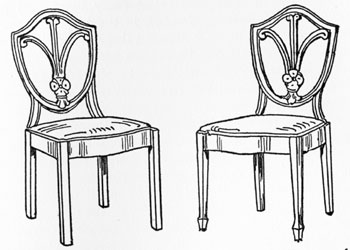Proportion
A furnished room does not grow as do the lilies of the field. It must be fashioned by studied creative processes. Yet it is the distinguishing characteristic and highest excellence of a perfectly furnished room that it appears to be not a creation but a growth. In every such room each part is so subtly related to all the other parts and to the whole that the relationship appears to be organic. As a result of faultless calculation there, is no evidence of calculation. The completed room seems to have grown spontaneously to a perfection to which nothing could be added and from which nothing could be taken away.
This organic harmony is dependent first of all upon proportion. Indeed proportion, or the relation or adaptation of one portion to another, or to the whole, as respects magnitude, quality or degree, is the dominant element in interior decoration, as it is in all the arts of design. Not only the beauty of every form in nature and in art, but its essential character and significance as well, is conditioned by the relationships borne by each of its parts to all the other parts and to the whole. The oak tree is beautiful, and so is the birch, and each has a fiber that is hard and enduring; yet we think always of the oak as sturdy, vigorous and indomitable, and of the birch as graceful, delicate and yielding. Similarly, the body of a perfectly developed athlete is always beautiful; yet no one expects the proportions of the wrestler or the weight-thrower to be the same as those of the runner or the vaulter. Each is beautiful in his own way, because the parts of his body are adapted not only to his stature, but also to the requirements of the game in which he is trained to compete. We can admire both; but we could by no possibility admire a form in which the great shoulders and torso of the one were joined to the slender hips and legs of the other. Inevitably such a form would appear grotesquely ugly in appearance and monstrous in significance.
The sense of proportion derived subconsciously from long familiarity with growing things, and particularly with the human body, conditions our artistic judgments. We expect to find things together which seem capable of having grown together; that is, things characterized by relationships analogous to the relationships existing among growing things. Thus we are best satisfied when the column or pilaster has both a capital, or head, and a plinth or foot; or when the ratio of valance to side hangings is the same as the ratio of head to body. And because the tree, fixed and immovable, has a trunk that tapers from bottom to top, while the animals, moving at will from place to place, have legs that taper from top to bottom, it happens that in the design of furniture the billiard table, which is fixed and immovable, may have legs that taper from bottom to top; that heavy sofas, chairs and tables which though not fixed are not easily movable, may have legs that do not taper either way; but that light and easily movable pieces, to satisfy the subconscious judgments of the mind, must have legs that taper from top to bottom.

FIGURE 23.- These small light chairs are identical except for the legs. Note that the example with tapering legs is far more satisfying than the one with legs which do not taper.
 "Finally! Step-by-Step Guidebooks Show
"Finally! Step-by-Step Guidebooks Show